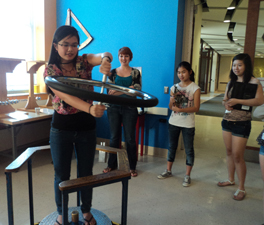|
Where Can You Witness First Hand the Wonders of Science?
Try the Ingersoll Physics Museum on the UW-Madison Campus
by Masha Vodyanik, age 15

Recently, a group of
Simpson Street Free Press
reporters and I took a trip to the UW Madison’s L.R. Ingersoll Physics Museum located in Chamberlin Hall. The museum featured hands-on physics demonstrations that appeal to young and old audiences alike. The exhibits were fascinating, and really grabbed our attention. We knew right away that this was a story we wanted to cover. The experiments that take place here explain physics in a way that even a younger child can understand. It is a place of exploration and discovery.
One of the first exhibits we came upon was the spinning platform. Our tour guide asked for a volunteer to step onto the platform and hold two weights, one in each hand. Then she asked us what would happen if the person had their arms out while they spun, and then stood with their arms held in. Without any logical explanation, we all agreed that if arms are out, the person would spin slower than if they were in.
Now it was time to test our hypothesis. Alex Lee, my fellow reporter, began spinning on the platform at a medium speed. As he was spinning, he slowly moved his arms out, parallel to his shoulders. The speed of the platform’s rotation was visibly reduced. When Alex pulled his arms in again, the speed increased. It was all like we predicted. But why does it work that way?
Our tour guide explained that Alex’s mass was more widely distributed over space when his arms were spread out, making him move more slowly. In contrast, when his arms were pulled in, his mass was closer to his middle, which made him spin faster. This is called the conservation of angular momentum.
After that experiment, we moved onto the probability board. The probability board was made up of many pegs in a checkerboard placement, with long columns underneath. Once the hundreds of little metal balls were released at the top of the pegboard, they would make their way down the pegs – either going left or right on each peg, and eventually falling into one of the columns. Once all of the balls went through the pegs, we noticed a mountain shape in the columns formed by the balls; the middle had the most in it, and the ones on the far ends had the least.
This was explained to us by Dan McCammon, an astrophysicist. He compared it to heads or tails. For example, when we flip a coin, we always have a 50% change of getting heads or tails. Because of that, the middle column was the most filled up since there was always a 50% chance for the ball to fall down the left or right peg. The balls on the far columns, however, were the only few that either went left or right their whole way down.
While we were there, we also learned many other things. We found out that scientists can study what far away planets and stars and determine their composition by using the light spectrum. By looking at the wavelengths of light, scientists can deduce which elements are present based on what colors of light are emitted by known elements.
At the museum, they had two mirrors that stood at an angle and came together. This allowed us to see what we look like to other people, since when we look in the mirror, we only see the mirrored image of us. When we looked in the mirrors, they reflected in a way that we could see our true image, not the mirrored image we see of ourselves daily.
At the end, we had some time to walk around and explore. All the experiments on display were very intriguing. They definitely got all of us more interested in physics. We left full of wonder and wanting to know more
The Ingersoll Physics Museum is open to all visitors from 8 a.m. to 4 p.m. Monday through Friday. It’s a great place for families to visit because the experiments you’ll see will make anyone curious. We strongly recommend you make this trip. At this museum, science truly comes alive.
|

